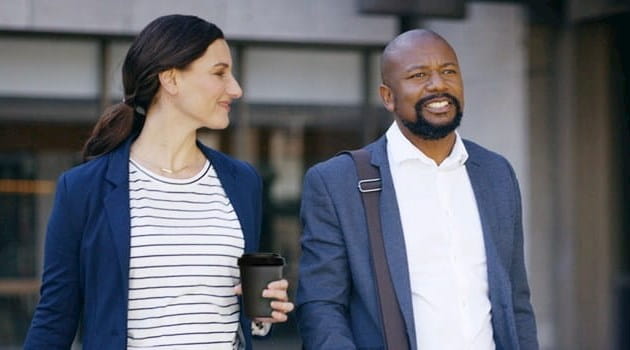“When you’re negotiating with a client, you want to give them all the comfort factors,” says Jonathan Finnerty, who runs modular eco building manufacturer Green Unit, but also trained as a chartered accountant in the early years of his career.
These ‘comfort factors’ involve setting expectations and allowing a client to be part of the process at any point – or in other words – ensuring transparency and building trust.
Green Unit, which has been in business for around 10 years, uses modern methods of construction, whereby 95% of the building is manufactured in a factory environment and then transferred to a site, which allows for a more efficient production process compared to traditional construction.
Finnerty says those methods, along with the business’s sustainability goals and its approach to customers, is what makes the firm stand out to clients.
“That chartered accountants code of conduct never goes away for me,” he says. “It’s that professionalism that is ingrained in how I’ve set up the business. To be accountable to the client in all stages of the production process, from the commencement of the engagement with a potential client to the contract stage to the financial accountability of the production, the installation and finally to the integrity and performance of the building over time.”
Picking the right client
Finnerty has set up the business so that some of the most important conversations come before any contracts are signed, in order to establish a solid foundation for a trusting business relationship.
“When clients come to us, we give them presentations of our factory and educate them about what being environmental means, but we also encourage them to look at other products, because what you can’t do in business is waste time only to find out they’ve gone elsewhere,” he says.
Green Unit’s buildings have a unique design, with curved walls and specific eco elements that are crucial to the company’s ethos.
“If a client comes and asks if we can make those walls straight, we just say to them, actually, the curves are integral to the design. And any client who says they don’t really want renewables and asks if we can halve the amount of insulation and make it 25% cheaper, the answer is no. We want it to be environmentally friendly, so we may not be the right choice for them,” Finnerty explains.
When a client chooses to move to the next stage and provides designs for planning permission, Green Unit charges a design fee of around £3,000 for an £800,000 building.
“What that gives us is a level of confidence that the client is serious about proceeding with us,” says Finnerty.
The next step in the process is the contract, which must be even-handed – vital for setting expectations and ensuring a trusting relationship over the duration of the manufacturing and installation process.
“A contract that does not overwhelm the client is critical,” says Finnerty. “And, of course, it’s a comfort for both parties to know it’s there. It controls documentation, schedules, delivery times and responsibilities for both parties.”
Communication
Beyond the formalities, Green Unit also prides itself on “thorough project management” and ensuring that clients are as involved in the process as they want to be. This reaches as far as online cameras on each production line in the factory.
“In traditional construction, you can just travel to the site to see how works are progressing. We’ve tried to replicate that by giving the client access to the factory whenever and however they want,” says Finnerty.
Another process Green Unit has put in place is access to all the documents relating to the building online.
“There’s a daily log, which reports the stages of construction that are logged as completed. Clients can see all of that by logging in for themselves. And then there’s a weekly update meeting with the client as well,” explains Finnerty.
If any problems arise, the client is informed immediately.
“If there’s a problem with the supply of timber, for example, you may find that your timeline with the client is compromised,” he says.
The business also communicates with clients post-installation, in order to make sure there are no problems in the initial post-installation period.
Responsibility
Ultimately, Green Unit wants to be a responsible, trustworthy business – both with client relationships and with its environmentally friendly design and build.
This environmental responsibility comes in two elements. First, how much carbon is used in the construction of the building, and second, the performance of the building.
For the first element, the business uses as many local British sustainable raw materials as possible in order to cut down the carbon miles. The factory also manages its waste streams, and by using a production line model, can create efficiencies that wouldn’t be possible on traditional construction sites.
As part of this, the business is aiming to be net zero for carbon by Q4 of 2023, and by 2025 at the latest.
Secondly, Green Unit spent between six and seven years prototyping the building to ensure it was a good product in a number of different sector settings from education, healthcare, visitor centres, hospitality and offices to retirement residential, and continues to make improvements in order to ensure the performance of the building.
“We want to be at the cutting edge of technology,” says Finnerty.
Green Unit uses renewable energy such as heat pumps and is now trialling curved solar panels for the roofing of the buildings.
“Continuous improvement is critical in order to ensure the performance of the building is the best it can be so that it can meet its environmental targets,” he says.
With the client’s permission, Green Unit installs measurement tools to monitor the buildings’ performance over time so the client is kept informed if there are concerns about heat loss and air quality, which might be due to how the client is using the building.
The business has also signed up to the One Planet Living framework, which helps direct business efforts in how sustainable its production processes and materials are to the ethical treatment of its staff, customers and suppliers, and the whole community it is connected with.
In order to invest in the future of green technology, Green Unit is engaging in a knowledge-transfer partnership organised through Innovate UK with Oxford Brookes University, which will be a “door into acres of knowledge” on cutting-edge renewable technology and sustainable design, according to Finnerty.
“Those things underpin everything that we’re doing to be an ethical and environmental business – the two key aspects that lie at the core of the business,” he says.
For more information on Green Unit visit their website
COP26: acting together
Find inspiration, information and practical resources to support the goals of the UN Climate Change Conference in Glasgow and explore why it represents a critical time for the profession.



